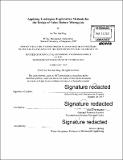| dc.contributor.advisor | Donna H. Rhodes. | en_US |
| dc.contributor.author | Ong, Ke Wei Joel | en_US |
| dc.contributor.other | System Design and Management Program. | en_US |
| dc.date.accessioned | 2017-06-21T18:21:17Z | |
| dc.date.available | 2017-06-21T18:21:17Z | |
| dc.date.copyright | 2017 | en_US |
| dc.date.issued | 2017 | en_US |
| dc.identifier.uri | http://hdl.handle.net/1721.1/110141 | |
| dc.description | Thesis: S.M. in Engineering and Management, Massachusetts Institute of Technology, School of Engineering, System Design and Management Program, 2017. | en_US |
| dc.description | Cataloged from PDF version of thesis. | en_US |
| dc.description | Includes bibliographical references (pages 90-94). | en_US |
| dc.description.abstract | Microgrids enhance resilience in power distribution by providing the capability to be islanded from the utility grid and sustain electricity delivery using distributed energy resources. Microgrids are also able to accommodate a higher mix of renewable energy sources that bring about reduced carbon emissions. However, the increasing complexities that come with decentralizing power generation and the integration of cyber elements pose new challenges in making design decisions. In this thesis, two tradespace based methods are proposed for choosing value-robust microgrid designs during the conceptual design stage. A value-robust design is one that is able to sustain delivery of perceived value to stakeholders, even when subjected to changes in contexts and needs. Multi-Attribute Tradespace Exploration (MATE) enables decision makers to evaluate a large number of design alternatives against utility and expense metrics that capture the stakeholder-perceived value. A full tradespace exploration avoids premature fixation on local point solutions and provides a more in-depth appreciation of the design space. Epoch-Era Analysis (EEA) provides a dynamic perspective of the system to enable the evaluation of value robustness across time periods with changing contexts and value expectations. The value robustness of a design can be quantified by analyzing tradespaces across different value-centric time periods or epochs. Designs that are found to exhibit high value robustness can be identified as candidates for detailed design. A constructed case study of a military microgrid is presented to demonstrate the use of MATE and EEA to find highly value-robust designs. While traditional design approaches tend to limit decision-making to a choice among given alternatives, MATE and EEA focus on the fundamental values of decision makers, allowing them to generate alternatives and discover high value designs. | en_US |
| dc.description.statementofresponsibility | by Ke Wei Joel Ong. | en_US |
| dc.format.extent | 94 pages | en_US |
| dc.language.iso | eng | en_US |
| dc.publisher | Massachusetts Institute of Technology | en_US |
| dc.rights | MIT theses are protected by copyright. They may be viewed, downloaded, or printed from this source but further reproduction or distribution in any format is prohibited without written permission. | en_US |
| dc.rights.uri | http://dspace.mit.edu/handle/1721.1/7582 | en_US |
| dc.subject | Engineering and Management Program. | en_US |
| dc.subject | System Design and Management Program. | en_US |
| dc.title | Applying tradespace exploration methods for the design of value-robust microgrids | en_US |
| dc.type | Thesis | en_US |
| dc.description.degree | S.M. in Engineering and Management | en_US |
| dc.contributor.department | Massachusetts Institute of Technology. Engineering and Management Program | en_US |
| dc.contributor.department | System Design and Management Program. | en_US |
| dc.identifier.oclc | 987232116 | en_US |
